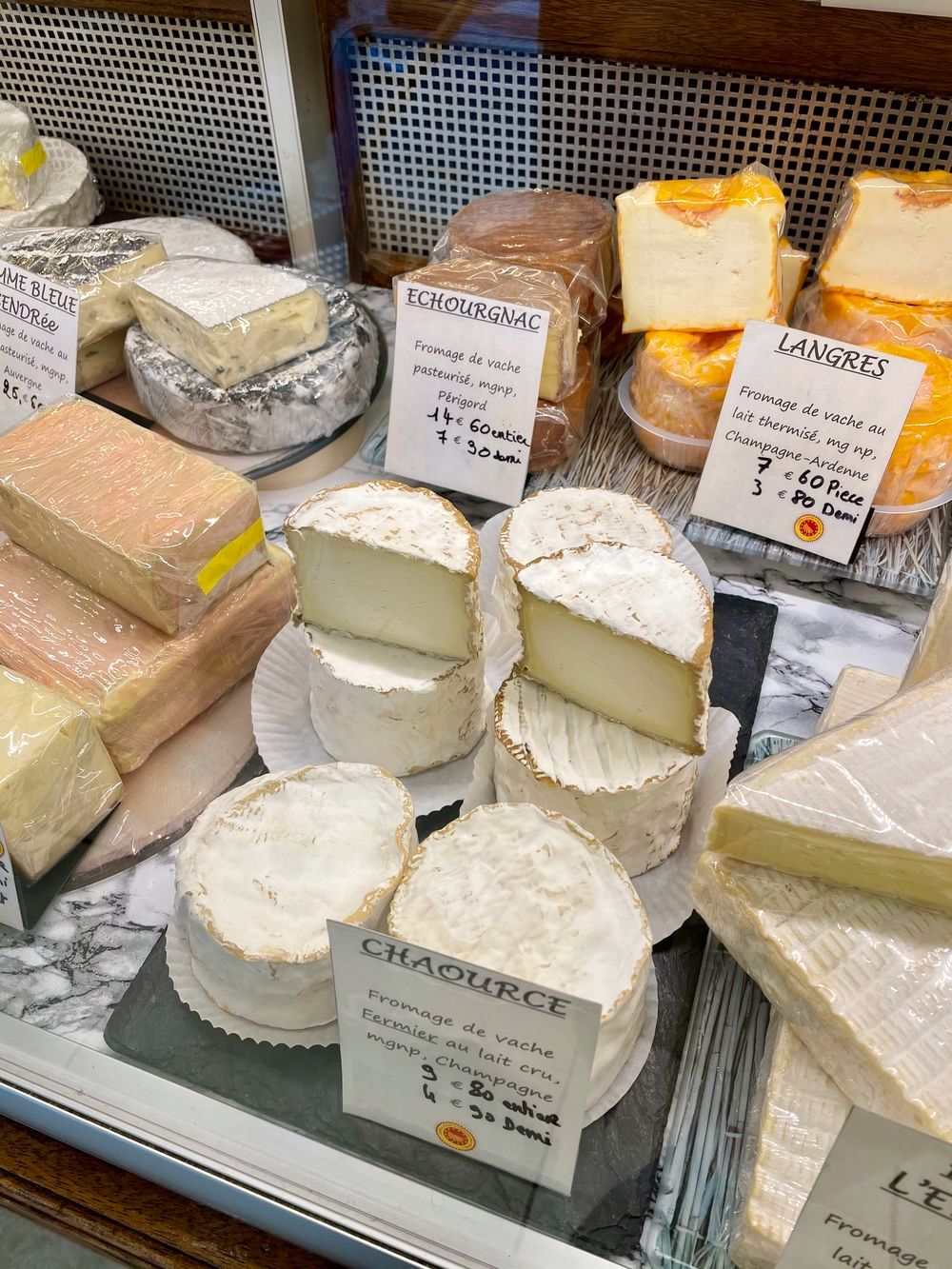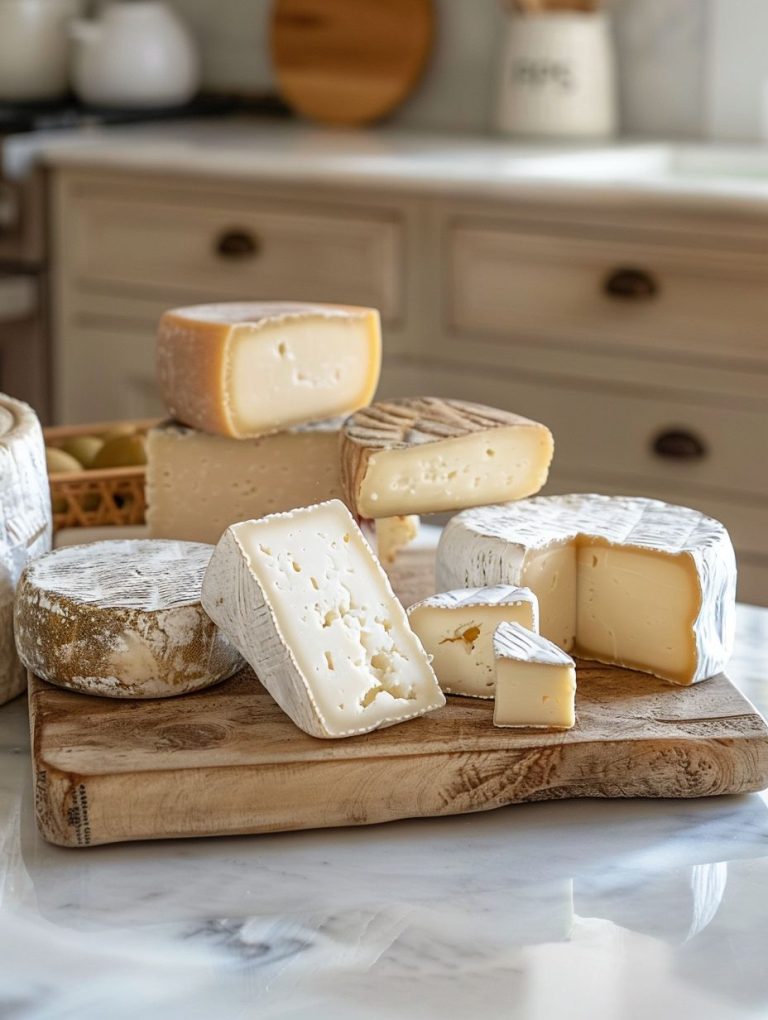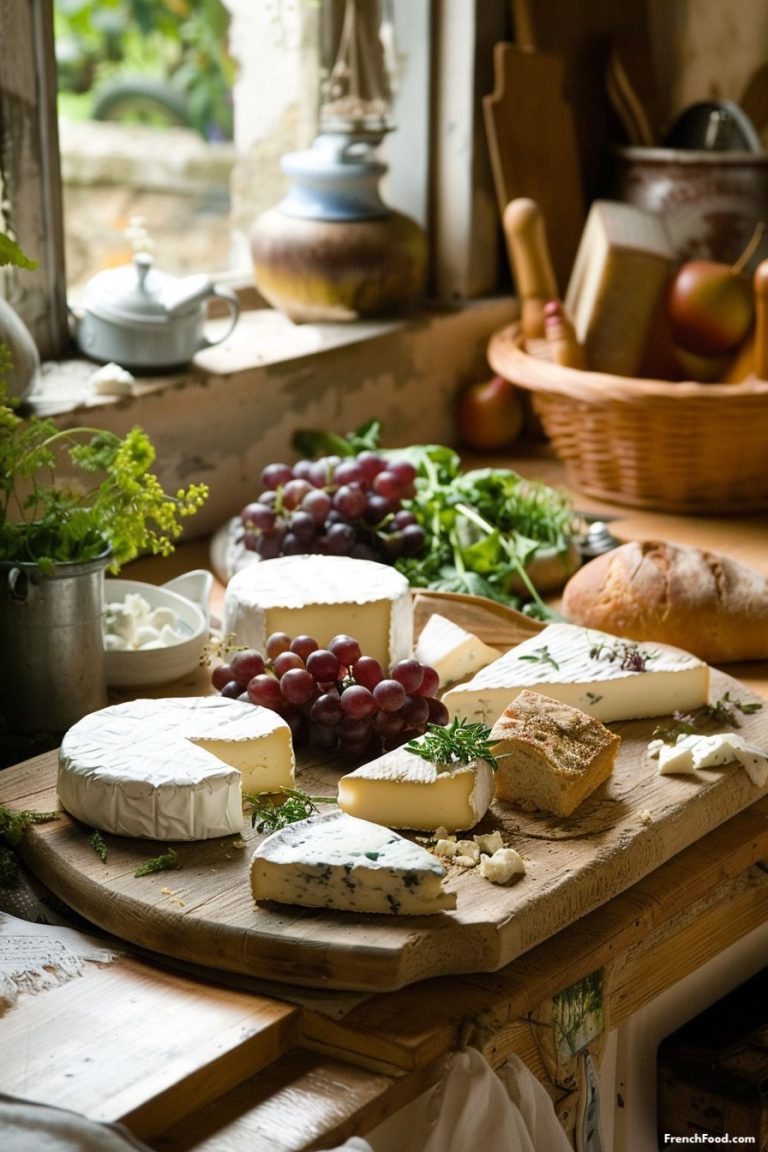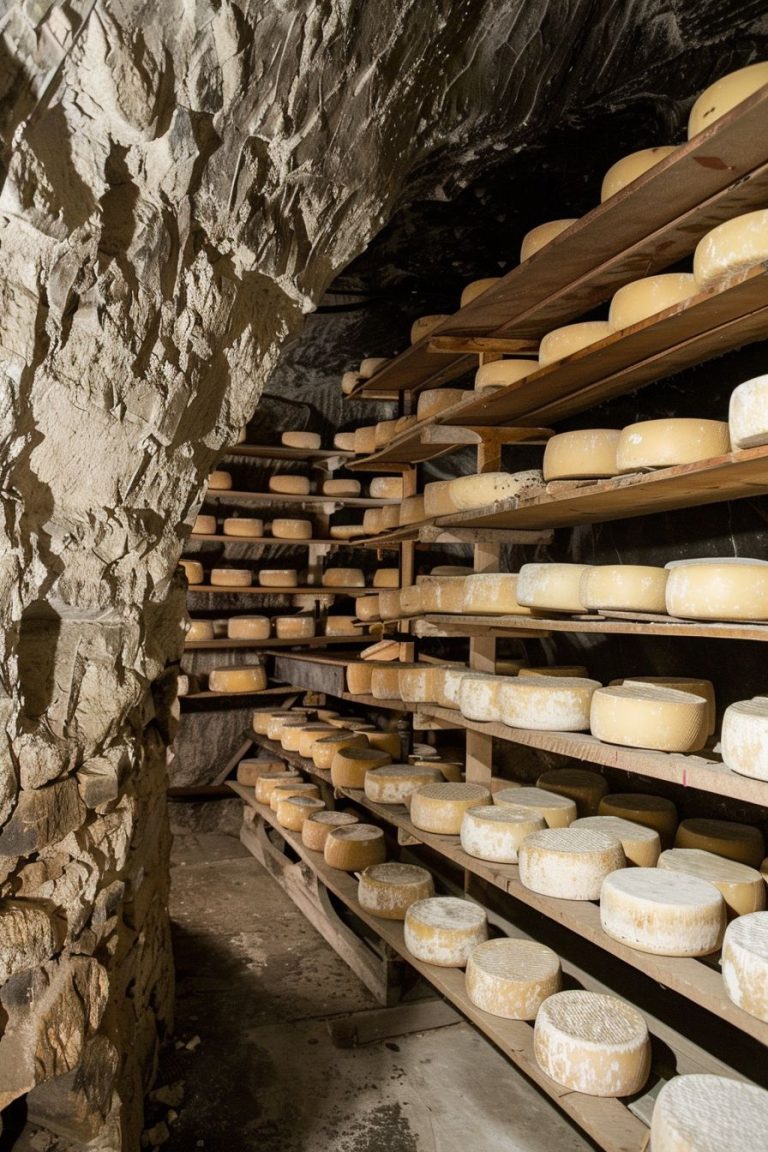9 Types of French Cheese: A Guide to the Iconic Varieties of France
We may earn a commission through all links on this website. As an Amazon Associate, we earn from qualifying purchases.In French gastronomy, cheese holds a special place. It’s embedded into French culture so much so that mentioning the word “cheese” immediately conjures up images of France!
France has hundreds of different types of cheeses, and estimates put the total number at over a thousand.
French cheeses are grouped into “families” based on their shared characteristics, such as texture, milk type, and production methods.
The primary cheese families include soft-ripened and bloomy-rind cheeses (like Brie), washed-rind cheeses (like Epoisses), blue cheeses (like Roquefort), semi-hard cheeses (like Tomme), hard cheeses (like Comté), goat cheeses, processed cheeses, and fresh, unripened cheeses (like Fromage Blanc).
Cheese Families and Categories
French cheese is classified into eight categories, or Les Huit Familles de Fromage. These official categories are based on factors like the type of milk used, the duration of aging, and the geographical origin.
They include:
Fresh Cheeses (Fromages Frais)
Fresh cheeses, known as “Fromages Frais” in French, are young, mild, and have a high moisture content. These cheeses are typically consumed shortly after production and are not aged for an extended period. They are known for their soft, creamy texture and delicate flavors. Fresh cheeses are often enjoyed for their simplicity and versatility.
Common examples of fresh cheeses include:
- Fromage Blanc: A creamy, unripened cheese that is similar to cream cheese but has a tangy flavor.
- Chèvre Frais: Fresh goat cheese, known for its creamy texture and mild, slightly tangy flavor.
- Petit Suisse: A small, cylindrical cheese with a velvety texture, typically enjoyed with sugar, honey, or fruit.
- Brousse du Rove: A fresh cheese made from goat’s milk, originating from the Provence region. It has a mild and slightly sweet flavor.
- Faisselle: A fresh curd cheese often served with cream or sugar. It has a delicate, lumpy texture.
- Crottin de Chavignol: While this cheese is usually aged, the fresh version is also available. It’s a goat cheese with a soft and creamy interior when young.
- Fromage Frais du Maconnais: A fresh cheese from the Maconnais region, known for its soft and creamy texture.
- Brocciu: A Corsican fresh cheese made from either goat or ewe’s milk. It has a slightly granular texture and is used in various Corsican dishes.
- Cerilly: A fresh, lactic cheese from the Auvergne region with a mild and milky taste.
These cheeses are typically mild and versatile, making them suitable for spreading on bread, adding to salads, or incorporating into desserts. They are distinct from aged cheeses, which undergo a longer maturation process, leading to more complex flavors and textures.
Soft Cheeses with Natural Rind (Fromages à Pâte Molle et à Croûte Fleurie)
Soft cheeses with natural rinds, known as “Fromages à Pâte Molle et à Croûte Fleurie” in French, are cheeses that have a soft, often creamy texture and are characterized by a bloomy or “fleurie” rind. This type of rind is formed by the growth of edible molds on the surface of the cheese. Here are a few examples of French soft cheeses with natural rinds:
- Brie: A classic French cheese with a creamy texture and a bloomy rind. Brie is mild and buttery, originating from the Île-de-France region.
- Camembert: Hailing from Normandy, Camembert is a soft, creamy cheese with a bloomy rind. It has a distinct earthy and mushroom-like flavor.
- Chaource: A soft, cow’s milk cheese from the Champagne-Ardenne region. It has a creamy interior and a velvety, white rind.
- Livarot: A pungent, washed-rind cheese from Normandy with a soft interior and an orange-brown rind. It’s often referred to as the “Colonel” due to the three strips of paper around the cheese.
- Coulommiers: Similar to Brie, Coulommiers is a soft cheese with a bloomy rind. It is smaller in size and slightly thicker than Brie.
- Saint-Marcellin: A small, soft cheese from the Rhône-Alpes region. It has a creamy texture and a natural, bloomy rind.
- Valençay: Although it’s often pyramid-shaped, Valençay can also have a round form. This goat cheese has a wrinkled rind and a thick, creamy interior.
- Munster: A strongly scented cow’s milk cheese from the Alsace and Lorraine regions. It has a soft interior and an orange rind.
These soft cheeses with natural rinds are appreciated for their rich, creamy textures and the complex flavors that develop as they mature.
Soft Cheeses with Washed Rind (Fromages à Pâte Molle et à Croûte Lavée)
Soft cheeses with washed rinds, known as “Fromages à Pâte Molle et à Croûte Lavée” in French, are cheeses that experience a process where the surface is regularly washed or brushed with a solution, often containing brine or alcohol. This process helps develop a distinctive aroma, flavor, and a characteristic orange or reddish rind.
- Époisses: A strong-smelling cow’s milk cheese from the Burgundy region. This creamy cheese has a distinctive orange-red washed rind. Époisses is known for its robust flavor.
- Pont-l’Évêque: Originating from Normandy, Pont-l’Évêque is a square-shaped, cow’s milk cheese with a washed rind. It has a mild, fruity flavor and a creamy texture.
- Livarot: Mentioned earlier in the soft cheeses with natural rinds, Livarot is a pungent cheese with a washed rind. It has a soft interior and is known for its strong aroma.
- Munster: Also mentioned earlier, Munster is a cow’s milk cheese, originating from the Alsace and Lorraine regions. It has a strong flavor and a creamy interior.
- Maroilles: A cow’s milk cheese from the northern regions of France, Maroilles has a washed rind that gives it a distinctive orange color. It has a strong aroma and a tangy flavor.
- Langres: Hailing from the Champagne-Ardenne region, Langres is a cow’s milk washed rind cheese. It has a concave top, which is often filled with a small amount of Champagne.
- Saint-Nectaire: A semi-soft, cow’s milk cheese from the Auvergne region, Saint-Nectaire has a washed rind and a smooth, creamy texture with a mild, nutty flavor.
These soft cheeses with washed rinds are known for their bold flavors, aromatic profiles, and the distinctive appearance of their rinds. The washing process contributes to the development of unique characteristics in these cheeses.
Pressed Cheeses (Fromages à Pâte Pressée)
Pressed cheeses, known as “Fromages à Pâte Pressée” in French, undergo a pressing process during their production. This pressing helps expel whey from the curds, resulting in a firmer texture. These are examples of French-pressed cheeses:
- Comté: A famous cow’s milk cheese from the Jura region, Comté is a firm, pressed cheese with a complex flavor profile that can range from nutty to fruity, depending on the age.
- Emmental: Originating from Switzerland but also produced in the eastern regions of France, Emmental is a classic pressed cheese with characteristic holes. It has a mild, nutty flavor.
- Beaufort: Produced in the Savoie region, Beaufort is a cow’s milk cheese with a firm, pressed texture. It has a rich and creamy flavor, often described as nutty and slightly sweet.
- Abondance: Another cheese from the Savoie region, Abondance is a semi-hard, pressed cheese with a smooth texture. It has a fruity and nutty taste.
- Tomme de Savoie: This cheese comes in various varieties, and some are pressed. Tomme de Savoie is a general term for a group of semi-firm cheeses with flavors often featuring earthy and fruity notes.
- Morbier: Originating from the Franche-Comté region, Morbier is a semi-soft cheese with a line of ash running through the middle. It has a creamy texture and a mild, fruity flavor.
- Saint-Paulin: A mild and creamy cow’s milk cheese with a smooth, orange rind, Saint-Paulin is a pressed cheese that originated in the 19th century.
- Cantal: Produced in the Auvergne region, Cantal is a firm, pressed cheese with a dense texture. It comes in various ages, from young and mild to aged and sharp.
Pressed cheeses are often enjoyed on their own, in sandwiches, or melted in various dishes. The pressing process contributes to their firmness and allows for a longer shelf life than some softer varieties.
Pressed and Cooked Cheeses (Fromages à Pâte Pressée et Cuite)
Pressed and cooked cheeses, known as “Fromages à Pâte Pressée et Cuite” in French, experience both pressing and heating during their production. This process involves heating the curds, pressing them, and then aging the cheese to develop its flavors and textures. Here are some examples:
- Gruyère: Stemming from Switzerland but also cultivated in eastern regions of France, Gruyère is a firm, pressed, and cooked cheese. It has a rich and nutty flavor, making it popular for both cooking and eating.
- Beaufort d’Été: This variety of Beaufort cheese is made during the summer months in the Alps. It has a firm texture and a complex, nutty taste.
- Emmental de Savoie: Similar to Emmental from Switzerland, Emmental de Savoie is a French variation of the pressed and cooked cheese. It has the characteristic holes and a mild, nutty flavor.
- Abondance: is also considered pressed and cooked. It is produced in the Savoie region and has a firm texture with a fruity and nutty flavor.
- Comté: While Comté is primarily classified as a pressed cheese, it also undergoes a cooking process during production. It is a versatile cheese with a complex flavor profile.
- Reblochon: A semi-soft, pressed, and washed-rind cheese from the Savoie region, Reblochon has a creamy texture and a distinct aroma. It is often used in traditional dishes like Tartiflette.
- Saint-Nectaire: Mentioned earlier in the pressed cheese category, Saint-Nectaire has a smooth texture and a rich, creamy flavor.
These cheeses are known for their firm textures, melting qualities, and diverse flavor profiles. They are often used in cooking, especially in traditional Alpine dishes, but are also enjoyed on cheese boards or as standalone treats.
Blue Cheeses (Fromages à Pâte Persillée)
Blue cheeses, known as “Fromages à Pâte Persillée” in French, are cheeses characterized by blue or green mold veins. These veins develop during the cheese-making process due to specific mold cultures, such as Penicillium roqueforti. Here are some examples of French blue cheeses:
- Roquefort: A famous blue cheese made from sheep’s milk, Roquefort is produced in the caves of the Combalou mountain in the Aveyron region. It has a crumbly surface and a sharp, tangy flavor.
- Bleu d’Auvergne: Produced in the Auvergne region, this cow’s milk blue cheese has a creamy texture with blue veins. It has a bold and robust flavor.
- Fourme d’Ambert: One of the oldest French blue cheeses, Fourme d’Ambert is made from cow’s milk in the Auvergne region. It has a creamy inside and a milder blue flavor.
- Bleu des Causses: Produced in the Causses region, this cheese is made from sheep’s milk. It crumbles into a well-balanced, tangy flavor.
- Saint Agur: A creamy and milder blue cheese made from pasteurized cow’s milk, Saint Agur is produced in the Auvergne region. It is known for its smooth texture and mild blue taste.
- Bleu du Vercors-Sassenage: Produced in the Vercors Massif region, this blue cheese is made from cow’s milk. It has a crumbly texture and a distinct blue flavor.
- Valdeon: Although not French, Valdeon is a blue cheese from the Picos de Europa region in Spain. It’s often included in discussions of French blue cheeses due to its similarities. Valdeon is made from cow, goat, and sheep’s milk.
These blue cheeses vary in texture, flavor intensity, and milk sources. They are often enjoyed on their own, crumbled on salads, or incorporated into various recipes.
Goat Cheeses (Fromages de Chèvre)
Goat cheeses, known as “Fromages de Chèvre” in French, are made primarily or exclusively from goat’s milk. France is particularly renowned for its delicious goat cheeses in various textures and flavors. Here are some examples of French goat cheeses:
- Chèvre Frais: Chèvre Frais refers to fresh goat cheese. It is soft, creamy, and mild, often enjoyed as a spread or in salads.
- Crottin de Chavignol: Produced in the Loire Valley, Crottin de Chavignol is a small, cylindrical goat cheese with a crumbly texture when young and a firmer texture as it ages. It has a nutty and earthy flavor.
- Valençay: Originating from the Berry region, Valençay is a pyramid-shaped goat cheese with a unique ash-covered rind. It has a firm, dense texture and a citrusy flavor.
- Bûcheron: Bûcheron is a semi-aged goat cheese that is cylindrical in shape. It has a bloomy rind, creamy interior, and a mild, earthy taste.
- Pouligny-Saint-Pierre: Produced in the Berry region, Pouligny-Saint-Pierre is a small, truncated pyramid-shaped goat cheese. It has a wrinkly rind and a dense, chalky texture with a nutty flavor.
- Picodon: Hailing from the Rhône-Alpes and Auvergne regions, Picodon is a small, round goat cheese with a wrinkly rind. It can have a creamy or crumbly texture, depending on its age.
- Chabis: Chabis is a fresh goat cheese that is either cylindrical or pyramid-shaped. It has a mild, lemony flavor and a smooth texture.
- Le Chevrot: Produced in the Poitou-Charentes region, Le Chevrot is a small, disc-shaped goat cheese with a wrinkled rind. It has a creamy texture and a tangy, nutty taste.
These goat cheeses showcase the diversity of flavors and textures found in French goat cheese production. They are often consumed alone or incorporated into various dishes, adding a distinct and delightful taste to the culinary experience.
Processed Cheeses (Fromages Fondus)
Processed cheeses, known as “Fromages Fondus” in French, refer to cheeses that have undergone a melting and blending process, often with the addition of emulsifying salts and other ingredients. These cheeses are typically smooth with a creamy texture, making them suitable for melting. Here are examples of French processed cheeses:
- La Vache Qui Rit: Also known as “The Laughing Cow” in English, La Vache Qui Rit is a well-known processed cheese brand in France. It is recognized for its iconic round portions with a red wax coating and a creamy, mild flavor.
- Kiri: Kiri is a brand of processed cheese that originated in France. It is often sold in small, individually wrapped portions and has a mild, creamy taste.
- Boursin: While Boursin is primarily known for its herbed cream cheese, the brand also offers processed cheese varieties. These cheeses often feature additional flavors like garlic and herbs.
- Babybel: Produced by the Bel Group, Babybel is a brand of small, round, and individually portioned processed cheeses. They are often encased in wax and have a mild, creamy flavor.
- Tartare: Tartare is a processed cheese spread available in flavors like garlic and herbs. It is suitable for spreading on bread or crackers.
- Caprice des Dieux: While Caprice des Dieux is typically associated with soft, surface-ripened cheese, the brand also offers a processed cheese version with a creamy texture.
- Apéricube: Apéricube is a popular brand offering small, cube-shaped portions of processed cheese, often served as snacks or appetizers. It comes in various flavors.
These examples represent the diversity of processed cheeses available in France. Processed cheeses are often convenient for spreading, dipping, or melting.
I hope this post inspired you to go eat some yummy French cheese – no matter where you are!







